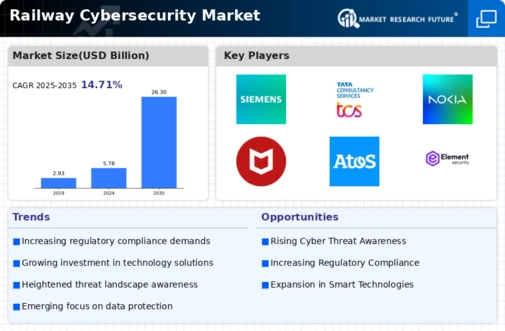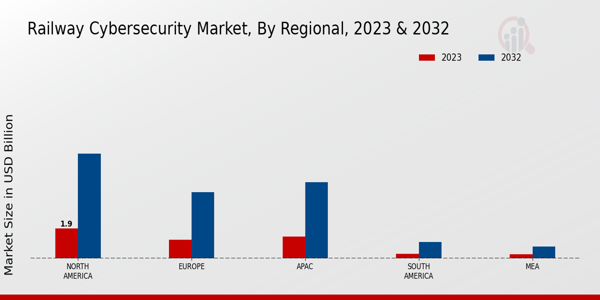Regulatory Compliance
Regulatory frameworks are becoming more stringent, compelling railway operators to enhance their cybersecurity protocols. The Global Railway Cybersecurity Market Industry is influenced by various regulations aimed at protecting critical infrastructure. For example, the U.S. Department of Homeland Security has implemented guidelines that require rail operators to adopt comprehensive cybersecurity measures. Compliance with these regulations not only mitigates risks but also fosters trust among stakeholders. As a result, investments in cybersecurity are expected to increase, contributing to the market's growth trajectory. By 2035, the market is anticipated to expand to 26.3 USD Billion, driven by the need for adherence to evolving regulatory standards.
Increasing Cyber Threats
The Global Railway Cybersecurity Market Industry is witnessing a surge in cyber threats, which necessitates robust cybersecurity measures. With the rise of sophisticated cyberattacks targeting critical infrastructure, railways are increasingly vulnerable. For instance, the European Union Agency for Cybersecurity reported a significant increase in incidents affecting transportation systems. This growing threat landscape compels railway operators to invest in advanced cybersecurity solutions, thereby driving market growth. The market is projected to reach 5.78 USD Billion in 2024, reflecting the urgency of addressing these vulnerabilities. As the industry evolves, the focus on cybersecurity becomes paramount to ensure the safety and reliability of railway operations.
Market Growth Projections
The Global Railway Cybersecurity Market Industry is projected to experience substantial growth over the next decade. With a market value of 5.78 USD Billion in 2024, the industry is set to expand at a remarkable CAGR of 14.78% from 2025 to 2035, ultimately reaching 26.3 USD Billion by 2035. This growth trajectory is indicative of the increasing recognition of cybersecurity as a critical component of railway operations. Factors such as rising cyber threats, regulatory pressures, and technological advancements are likely to contribute to this upward trend. The market's expansion reflects the urgent need for comprehensive cybersecurity solutions in the railway sector.
Technological Advancements
The integration of advanced technologies such as artificial intelligence and machine learning is transforming the Global Railway Cybersecurity Market Industry. These technologies enhance threat detection and response capabilities, enabling railway operators to proactively address potential cyber threats. For instance, AI-driven analytics can identify anomalies in network traffic, allowing for swift intervention. As railway systems become more interconnected, the complexity of cybersecurity challenges increases, necessitating innovative solutions. The market is projected to grow at a CAGR of 14.78% from 2025 to 2035, reflecting the impact of technological advancements on enhancing cybersecurity measures within the railway sector.
Public Awareness and Demand for Safety
There is a growing public awareness regarding cybersecurity threats in the transportation sector, particularly railways. The Global Railway Cybersecurity Market Industry is responding to this heightened demand for safety and security. As incidents of cyberattacks gain media attention, passengers and stakeholders are increasingly concerned about the integrity of railway systems. This awareness drives railway operators to prioritize cybersecurity investments, ensuring the protection of sensitive data and operational continuity. The market is expected to expand significantly, reaching 26.3 USD Billion by 2035, as public demand for secure and reliable rail services continues to rise.
Growing Investment in Smart Rail Systems
The shift towards smart rail systems is significantly influencing the Global Railway Cybersecurity Market Industry. As rail operators adopt IoT and digital technologies to enhance operational efficiency, the need for robust cybersecurity frameworks becomes critical. Smart rail systems, while improving service delivery, also introduce new vulnerabilities that cybercriminals may exploit. Consequently, railway companies are allocating substantial resources to fortify their cybersecurity infrastructure. This trend is expected to drive market growth, with the industry poised to reach 5.78 USD Billion by 2024. The emphasis on securing smart technologies will likely shape the future landscape of railway cybersecurity.























